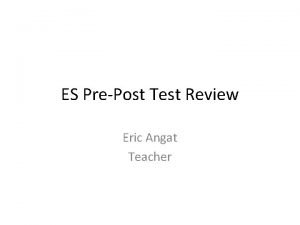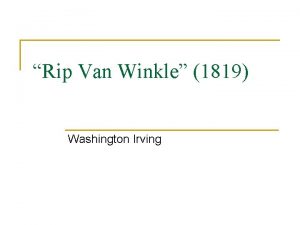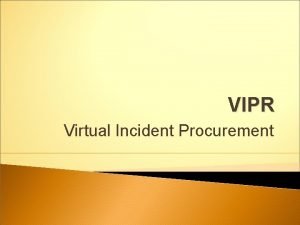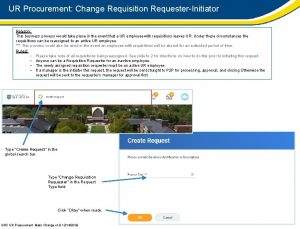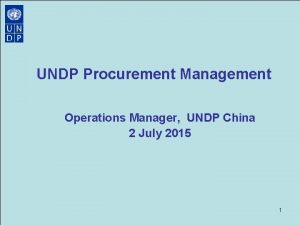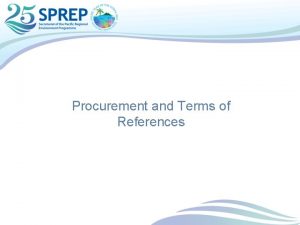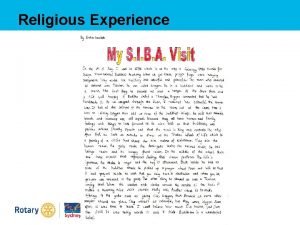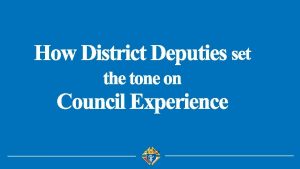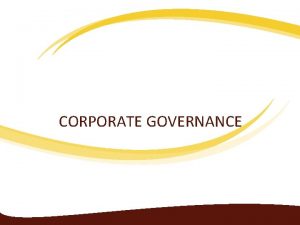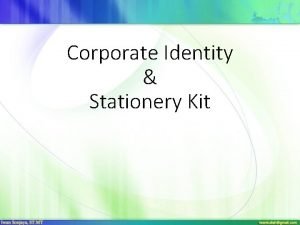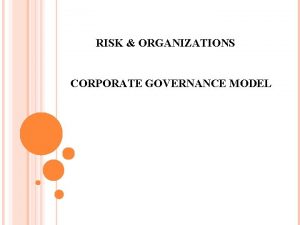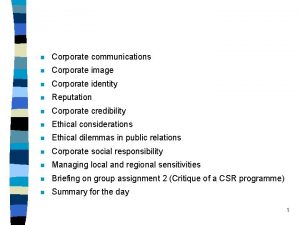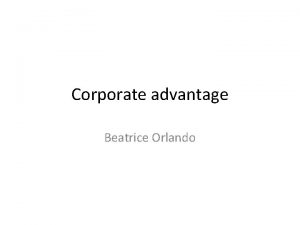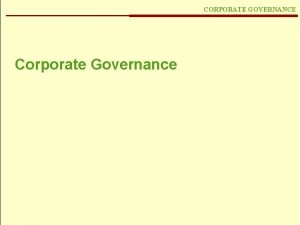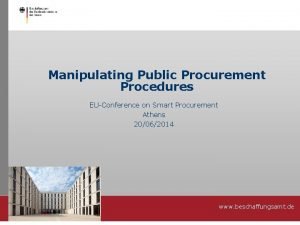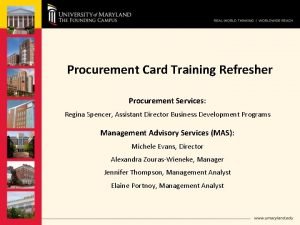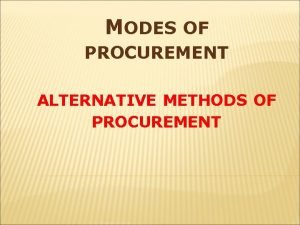CORPORATE RE PROCUREMENT WHY HOW Experience of corporate
























- Slides: 24

CORPORATE RE PROCUREMENT: WHY & HOW? Experience of corporate leaders & perspectives of WRI about renewable energy procurement in India. ASHOK THANIKONDA, DEEPAK KRISHNAN. GPMDG NATIONAL CONFERENCE. SEPTEMBER 15, 2015. HOTEL HILTON, CHENNAI.

Contents Part A: The theory of renewable energy procurement 1. 2. 3. 4. 5. 6. 7. 8. Drivers: Setting targets: Business model: Tendering: Due diligence: Negotiations: Contract signing: Communications: Why buy Renewable Energy? How much to buy? How to choose the business model? How to prepare tender and receive bids? How to mitigate the transaction risks? How to get the maximum value for your money? How to close the deal? How to communicate with your stakeholders about your leadership in sustainability? Part B: Experience of corporate leaders and perspective of WRI 1. An IT major’s experience with wind energy procurement 2. An FMCG corporate’s experience with solar power procurement 3. WRI’s Collaborative Solar procurement project Draft version

Part A: The theory of renewable energy procurement Drivers Targets Business case Business model Tendering Regulatory compliance Due diligence Negotiations Contract signing Sustainability commitments Cost per k. Wh of electricity from various sources in 2015 % average annual increase in electricity tariffs (FY 11 -15) ₹ 30 6, 56 6, 09 4, 5 4, 46 4, 3 4, 76 3, 5 Communications • Fossil fuel based electricity prices are rising sharply and continuously • Power deficit is a critical business risk 2, 5 • Renewable energy is already cheaper or competitive with grid power and supplements/ augments it HT HT LT LT Commercial Industrial TANGEDCO ₹ 14 Diesel power BESCOM Draft version ₹ 8. 5 ₹ 7. 5 ₹ 6. 5 ₹ 5. 85 ₹ 6. 5 ₹ 5. 5 Grid power Solar power Wind power

Part A: The theory of renewable energy procurement Drivers Targets Business case Business model Tendering Regulatory compliance Due diligence Negotiations Contract signing Communications Sustainability commitments Renewable Purchase Obligations (2015 -16) • Renewable Purchase Obligations (RPOs) mandate businesses that procure power from third parties to procure a share of such energy from renewable energy sources 5% • Almost all Indian states have notified penalties for RPO non-compliance Specifics under deliberation • Enforcement of penalties could soon become the norm 0, 25% Karnataka (> 5 MVa) Tamil Nadu (> 1 MVa) Non-solar RPO Draft version Solar RPO

Part A: The theory of renewable energy procurement Drivers Targets Business case Business model Tendering Regulatory compliance Due diligence Negotiations Contract signing Communications Sustainability commitments • Consumers increasingly prefer products/ services of companies that adhere to the principles of sustainability and operate accordingly • Reducing Green House Gas (GHG) emissions by shifting to renewable energy is proven to be an effective way of reducing impacts on the environment • Corporates are increasingly aware of this and consider it as one of the elements of their CSR strategy. They also include this as part of their brand positing by reaching out to their consumers about their leadership in sustainability Draft version

Part A: The theory of renewable energy procurement Drivers Targets Business model Tendering Due diligence Negotiations Contract signing Communications • RPOs usually have a direct impact on the renewable energy purchase ambition of a buyer • In the absence of RPOs, internal sustainability targets based on realistic assessment can define the quantum of purchase • Depending on the location and the tariff design, buyers usually stand to benefit to minimize their grid power consumption during a certain time block. This, in addition to the need to optimize, diesel and grid power can also impact the quantum of renewable energy procurement • Typically base load on non-working days acts as reference to decide on the quantum of renewable energy purchase Draft version

Part A: The theory of renewable energy procurement Drivers Targets Business model Tendering Surplus capital No surplus capital Due diligence Negotiations Capital investment Power Purchase Agreement Commercial buyers Industrial buyers Draft version Contract signing Communications

Part A: The theory of renewable energy procurement Drivers Targets Business model Tendering Due diligence Negotiations Contract signing Communications • Refer to other renewable energy procurement tenders for preliminary understanding • Employ internal technical, procurement and legal teams to prepare an tender documents that suit your needs • Hire external consultants if needed Draft version

Part A: The theory of renewable energy procurement Drivers Targets Business model Tendering Due diligence Negotiations Contract signing Communications • Ensure that the eligibility criteria for sellers to participate in your procurement are reflective of the minimum capabilities needed to serve your demand • Check the standing of the sellers against verified ranking systems: CRISIL ratings, MNRE empanelment etc. • Compare the product technical sheets against the prescribed standards • Ensure that the Seller signs performance guarantee clauses that are backed by suitable bank deposits • Dedicate qualified personnel and other resources to ensure highly scrutinized contractual terms Draft version

Part A: The theory of renewable energy procurement Drivers Targets Business model Tendering Due diligence Negotiations Contract signing • Undertake market research to assess the price points • Negotiate with as many credible sellers as possible to discover a competitive price point • Engage technical, financial, legal and procurement teams during negotiations Draft version Communications

Part A: The theory of renewable energy procurement Drivers Targets Business model Tendering Due diligence Negotiations Contract signing Communications • Crosscheck with all the teams internally before signing the contract • Ensure tight deadlines about project completion and force majeure clauses are embedded in the contract • Sign the contract with the developer that meets your technical, financial and other parameters Draft version

Part A: The theory of renewable energy procurement Drivers Targets Business model Tendering Due diligence Negotiations Contract signing Communications • Design a communications and outreach strategy about your renewable energy procurement • Engage your stakeholders through annual reports, press releases and social media etc. • Engage with platforms like the India GHGP to measure your sustainability performance and communicate it with your peers and all other stakeholders Draft version

Part B: Corporate experience & WRI’s perspective Wind Energy by an IT Major Drivers Business model Solar power by an FMCG corporate Risks perceived WRI’s Collab. Solar project Procurement Energy security Hedging against the rising coal (grid) and diesel prices Frequent power cuts (8 -10 hours) and heavy reliance on diesel generators was a big operational and business risk. Renewable Energy provided energy security. Grid prices were on the rise constantly. Diesel prices increased by 36% between 2012 and 2013 alone. Draft version Sustainability targets Renewable Energy procurement helped the company meet its internal sustainability targets.

Part B: Corporate experience & WRI’s perspective Wind Energy by an IT Major Drivers Business model Solar power by an FMCG corporate Risks perceived WRI’s Collab. Solar project Procurement Policy framework Changes in corporate charter Renewable Energy Certificates (RECs) The state’s policies favored group captive business model in which companies can co-invest in a single wind farm and consume at least 51% of power generated. The buyer’s corporate charter already had clauses that permitted its investment in power generation. The investment was made with an exit clause after 5 years. Renewable Energy Certificates (RECs) were purchased separately by the buyer. Draft version

Part B: Corporate experience & WRI’s perspective Wind Energy by an IT Major Drivers Business model Solar power by an FMCG corporate Risks perceived Demand quantification & optimization of diesel consumption To maximize the reliability/ savings and minimize the risks from renewable energy procurement, its quantum has to be optimized with that of grid & diesel generators. WRI’s Collab. Solar project Procurement Policy clarity & transparency Capital gains tax Potential changes in the policies could affect grid usage charges and hence the cost of power. This risks are covered in the force majeure clauses of the contract. There is a possibility of capital gains and hence a tax at the end of 5 year term when the seller buys back the asset. This is accounted for in the strategy by the financial team in their calculations. Draft version

Part B: Corporate experience & WRI’s perspective Wind Energy by an IT Major Drivers Business model Solar power by an FMCG corporate Risks perceived Procurement After signing the contract, there were immediate savings During peak wind season, because of the grid instability the wind mills were disconnected from the grid. Biomass power was sourced during this time to balance the shortfall. Draft version WRI’s Collab. Solar project

Part B: Corporate experience & WRI’s perspective Wind Energy by an IT Major Drivers Business model Solar power by an FMCG corporate Risks perceived Hedging against the rising coal (grid) and diesel prices Grid prices were on the rise constantly. They increased by 22% between 2009 and 2013 for industrial consumers in Karnataka. WRI’s Collab. Solar project Procurement Energy security Availability of a large roof that can support 1 MW posed an opportunity to offset expensive diesel and provide reliable supply is a driver. Draft version Sustainability targets Renewable Energy procurement helped the company meet its internal sustainability targets.

Part B: Corporate experience & WRI’s perspective Wind Energy by an IT Major Drivers Business model Solar power by an FMCG corporate Risks perceived Stakeholder sign-offs for investments in non-core businesses Capital investment decisions, especially beyond a certain quantum, have to be cleared by the headquarters. WRI’s Collab. Solar project Procurement Tenure and pricing of third party power purchase contracts Policy changes and reevaluation of strategy Typical tenure of third party solar power purchase contracts is 7 -10 years. Buyer wanted to sign a contract only for 5 years and exit easily. Rooftop solar at INR 7. 5/ k. Wh in a third-party purchase contract was attractive to the seller. The potential increase in cost due to an import tax on solar panels led to a strategic preference in capital investment mode. Draft version

Part B: Corporate experience & WRI’s perspective Wind Energy by an IT Major Drivers Business model Solar power by an FMCG corporate Risks perceived WRI’s Collab. Solar project Procurement Perforation of roof Buyer’s biggest concern was perforation of the metal sheet roofs during solar plant installation which could lead to leakage onto their process line. So they have chosen sellers who offer non-perforated solutions alone. Draft version

Part B: Corporate experience & WRI’s perspective Wind Energy by an IT Major Drivers Business model Solar power by an FMCG corporate Risks perceived Procurement Negotiations underway Buyer is currently making capital investment in rooftop solar for its facility in western India; as a pilot before scaling up across the country. In addition, buyer has devised a comprehensive country level solar power procurement strategy. All the green field facilities of buyer will now source at least 25% of their power requirements from on-site solar plants. Draft version WRI’s Collab. Solar project

Part B: Corporate experience & WRI’s perspective Wind Energy by an IT Major Concept Process Solar power by an FMCG corporate WRI’s Collab. Solar project Lessons learned Convening Single large bundle of demand for rooftop solar power Economies of scale Cheaper pricing Seller Buyers of various sizes Draft version

Part B: Corporate experience & WRI’s perspective Wind Energy by an IT Major Concept Process Solar power by an FMCG corporate WRI’s Collab. Solar project Lessons learned Socializing the concept (by WRI) Data collection from interested buyers (by WRI) Preliminary site visits (by WRI) Preparation and release of Request for Information (RFI) document (by WRI) Site visits and submission of proposals (by Sellers) Preparation and release of the RFP document (by WRI) Educating the buyers about decision making (by WRI) Analysis & screening of responses to RFI (by WRI) Analysis of the proposals (by WRI) Selection of the winners (by buyers) Draft version

Part B: Corporate experience & WRI’s perspective Wind Energy by an IT Major Concept Process Neither the sellers nor the buyer wants to pay for the unconsumed power over the weekends. Net-metering is possible solution in such cases. WRI’s Collab. Solar project Lessons learned Aggregate bundles at industrial park level to allow for fluctuations of demand supply Addressing weekend (dynamic) demand, deemed generation & net-metering Solar power by an FMCG corporate Segregate bundles using 2 x 2 matrix based on nature of buyer (commercial / industrial) and preference of business model (Capital investment / PPA) Addressing the data collection problems Signing Non-Disclosure Agreements (NDAs) and having detailed clauses about access/ ownership in the next phase can address most of the security concerns of buyers. For MNCs, capital investments need changes in corporate charter and clearance from the head quarters Clarify on “Collab. Solar rebate” Vs “Cross subsidy within the buyers” Roof space and ownership type Sellers are expected to give an individual price to each buyer based on their credentials and offer a uniform discount that is reflective of the Collab. Solar benefit. In case of buyers who operate out of leased spaces, sellers are not comfortable with a thirdparty PPA based rooftop solar PV installation. Tripartite agreement between the seller, landlord and the buyer is a possible solution in such cases. Draft version

THANK YOU • • • The three parts of this handout correspond to three publications that WRI is bringing out soon. This handout is meant for reference during the GPMDG National conference only. The final publications will cover issues presented here in depth with the help of more data, graphics and annexures. Please send your feedback to ashok. thanikonda@wri. org (or) dkrishnan@wri. org ASHOK THANIKONDA, DEEPAK KRISHNAN. GPMDG NATIONAL CONFERENCE. SEPTEMBER 15, 2015. HOTEL HILTON, CHENNAI.
 Hey hey bye bye
Hey hey bye bye Experience expectant vs experience dependent
Experience expectant vs experience dependent Continuity vs discontinuity
Continuity vs discontinuity Direct and indirect experience examples
Direct and indirect experience examples Dont ask
Dont ask Goal of corporate finance
Goal of corporate finance Why experience is important
Why experience is important Why do we experience seasons
Why do we experience seasons Why do we experience seasons
Why do we experience seasons Planes fly in which layer
Planes fly in which layer Why patient experience matters
Why patient experience matters Rip van winkle allegory
Rip van winkle allegory Why-why analysis
Why-why analysis Why do you cry willie why do you cry
Why do you cry willie why do you cry Does this table represent a function why or why not
Does this table represent a function why or why not Does this table represent a function why or why not
Does this table represent a function why or why not Why or why not
Why or why not Contoh laporan root cause analysis
Contoh laporan root cause analysis Project procurement management lecture notes
Project procurement management lecture notes Soda ash procurement
Soda ash procurement Swot analysis for procurement department
Swot analysis for procurement department Vipr forest service
Vipr forest service Ur procurement
Ur procurement Procurement principles
Procurement principles Tesco procurement strategy
Tesco procurement strategy









